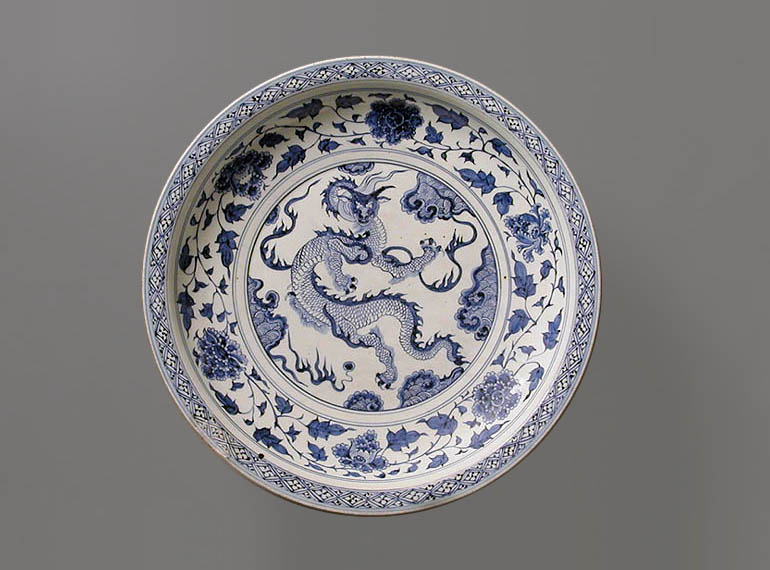Sep 16, 2003 10:00 EST
F. Gordon Morrill Collection/Chinese & Chinese Export Porcelain
75
MASSIVE BLUE AND WHITE PORCELAIN DRAGON DISH
Mid 14th century
Diameter 19 3/16 inches (48.7 cm)
The dish is painted in an inky blue with a single, rampant, celestial dragon exuding bands of flames and facing directly front. The design is enclosed by two double-line bands at the edge of the cavetto and within the inner band are six irregular outlines extending into the composition. These are edged by dark outlines and the areas inside these outlines are fitted with overlapping waves. Outside the central medallion is a wide band of six flowers (roses/peonies) connected by running foliage and on the flat rim is a continuous band of lozenge cells. The exterior is decorated with six flowerheads and running foliage.
PROVENANCE:
Ellsworth & Goldie, Ltd., New York, 17 December 1970, Ellsworth & Goldie inventory no. A-418
SIMILAR EXAMPLES:
Regina Krahl, Ceramics in the Topkapi Saray Museum, London, 1986, vol. II, no. 560, p. 391
John Alexander Pope, Chinese Porcelain from the Ardebil Shrine, Washington, D.C., 1956, pl. 15
EXHIBITED:
Museum of Fine Arts, Boston, October - November, 1971
ILLUSTRATED:
Oriental Art (review of the above exhibition), Spring, 1972
CONDITION:
Shallow chip on the lower left edge approximately 2 mm deep and measuring approximately 4.5 x 2 cm, small amount of wear in inside center glaze
This rare body of large blue and white dishes in various designs and large Longquan celadons appear to have been destined for the Middle East market as the majority of recorded examples are in the Topkapi Saray Museum in Istanbul or the Ardebil Shrine in Northern Iran, where they have been for the last six hundred years.
Only two other large single-dragon dishes appear to exist: one in the Topkapi Saray, and one in the Ardebil Shrine. In diameter they are 48 cm and 46 cm respectively, making the Morrill example the largest of the three. With the exception of a 57.5 cm phoenix dish in the Ardebil, this example appears to be the largest Yuan dish in existence.
The Topkapi dish is decorated with a single dragon on a background of massed clouds, the Ardebil dish, however, is almost identical to this example except that the dragon's head is seen in profile. On the Morrill example the head is depicted en face, making this the only known 14th century example of a dragon facing forward.
Reference is made to Margaret Medley, Arts Orientalis IX, "The Yuan Ming Transformations in the Blue and Red Decorations-Porcelains of China", p. 92 and pl. 1, fig. 2.
Sold for $1,875,000
Estimated at $700,000 - $900,000
Includes Buyer's Premium
MASSIVE BLUE AND WHITE PORCELAIN DRAGON DISH
Mid 14th century
Diameter 19 3/16 inches (48.7 cm)
The dish is painted in an inky blue with a single, rampant, celestial dragon exuding bands of flames and facing directly front. The design is enclosed by two double-line bands at the edge of the cavetto and within the inner band are six irregular outlines extending into the composition. These are edged by dark outlines and the areas inside these outlines are fitted with overlapping waves. Outside the central medallion is a wide band of six flowers (roses/peonies) connected by running foliage and on the flat rim is a continuous band of lozenge cells. The exterior is decorated with six flowerheads and running foliage.
PROVENANCE:
Ellsworth & Goldie, Ltd., New York, 17 December 1970, Ellsworth & Goldie inventory no. A-418
SIMILAR EXAMPLES:
Regina Krahl, Ceramics in the Topkapi Saray Museum, London, 1986, vol. II, no. 560, p. 391
John Alexander Pope, Chinese Porcelain from the Ardebil Shrine, Washington, D.C., 1956, pl. 15
EXHIBITED:
Museum of Fine Arts, Boston, October - November, 1971
ILLUSTRATED:
Oriental Art (review of the above exhibition), Spring, 1972
CONDITION:
Shallow chip on the lower left edge approximately 2 mm deep and measuring approximately 4.5 x 2 cm, small amount of wear in inside center glaze
This rare body of large blue and white dishes in various designs and large Longquan celadons appear to have been destined for the Middle East market as the majority of recorded examples are in the Topkapi Saray Museum in Istanbul or the Ardebil Shrine in Northern Iran, where they have been for the last six hundred years.
Only two other large single-dragon dishes appear to exist: one in the Topkapi Saray, and one in the Ardebil Shrine. In diameter they are 48 cm and 46 cm respectively, making the Morrill example the largest of the three. With the exception of a 57.5 cm phoenix dish in the Ardebil, this example appears to be the largest Yuan dish in existence.
The Topkapi dish is decorated with a single dragon on a background of massed clouds, the Ardebil dish, however, is almost identical to this example except that the dragon's head is seen in profile. On the Morrill example the head is depicted en face, making this the only known 14th century example of a dragon facing forward.
Reference is made to Margaret Medley, Arts Orientalis IX, "The Yuan Ming Transformations in the Blue and Red Decorations-Porcelains of China", p. 92 and pl. 1, fig. 2.
Auction: F. Gordon Morrill Collection/Chinese & Chinese Export Porcelain, Sep 16, 2003
